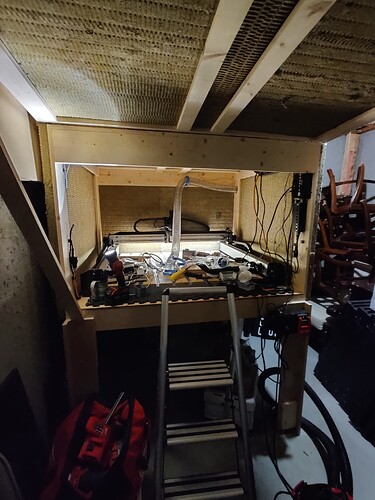I’ve designed enclosures for industrial air-moving equipment, so I might be able to provide some ideas/ insight.
First, remember that noise can fit through anything that air fits through, but has to have a line of sight to the source, or a way to “bounce” there, because it’s a wave. A closed chest freezer is great because it’s sealed, but that’s bad for airflow.
Second, high frequency noise has a shorter wavelength, so it can move efficiently through smaller gaps, but is also absorbed more easily.
Third, sound is directional, so any sound going backwards will only be heard if it has a path to bounce towards you.
With this is mind, figure out the dominant frequencies that bother you (or others), and design around those. If it’s 1kHz, that’s around 30cm wavelength. If you can create a “squishy” layer half that thickness, by the time it goes in, bounces, and comes back, it’ll have lost quite a bit of energy. Some 6" fiberglass batt insulation in a plastic bag works surprisingly well (since the bag is nearly transparent to the sound). This is the best way to “absorb” the sound energy from the back, sides, and bottom of the machine, which is 4 of the 6 cube faces, so a little more than half of it.
To contain sound, find something heavy. Mass-loaded vinyl is great since it damps well. Cement board is pretty good too, if held together with a gooey silicone caulk. Firecore (Type X) drywall with a layer of vinyl on it (plastidip, maybe?) is a good combination of mass plus damping.
If you were to take your chest freezer and tip it on its side, then pack the sides/ back around the machine with fiberglass, it would do well even with the door open. 3dB drop, at least, to the operator, and probably 5x that to anyone without line of sight. Add dust collection so it’s always drawing in fresh air (which helps keep things like electronics cool, too) and it might be a good enough solution.
If I were to design one from scratch so I could run it late at night without bugging the family, it would be a cement-board box lined with mineral wool board 6" thick, with a 1/8" vinyl curtain stapled to the outside. A single sheet of 1/4" plexi in the front would be gasketed on, and I’d make sure a path for airflow was channeled between layers of mineral wool, but drew fresh air across the board before going into the work area, then evacuated straight out through an insulated duct (like the flexible fiberglass ducts used in a house). I’d expect 12-15dB reduction from such a setup.
But a thick, heavy vinyl curtain between you and your “target” will do 5dB for about 1% of the effort.
![]()
![]()
![]()
![]()
